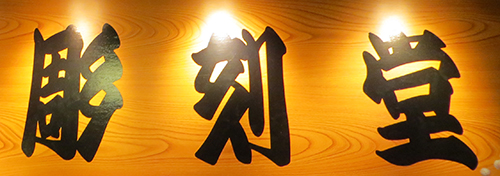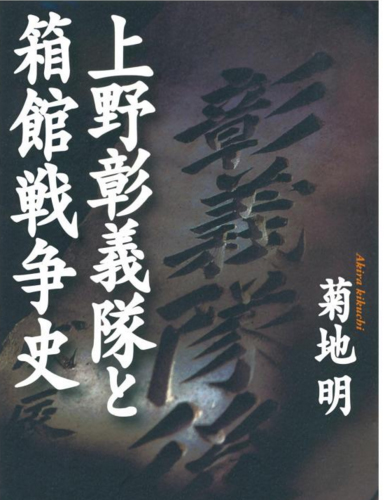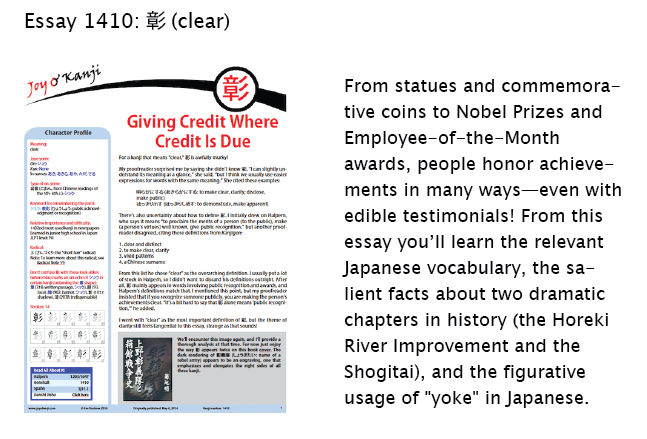Yoking Opposites
I find myself preoccupied with two photos, both related to what I've most recently posted.
Radical Note 59 on 彡, the "short hair" radical, includes this golden offering:

Photo Credit: Eve Kushner
In 彫刻 (ちょうこく: carving; engraving; sculpture), the diagonal strokes on the right side of 彫 practically mirror those on the left half of 刻. The only way this could have been even better is if the sign had featured this word:
彫刻家 (ちょうこくか: engraver; carver; sculptor)
Look at that! Each kanji features diagonal slashes, popping out as vividly as if they've been carved or engraved! Was this planned?!
In the next image, a book cover from the new essay 1410 on 彰 (clear), the black writing is ghostly and yet commanding:

It's as if we're seeing three-dimensional writing, either a depression (intaglio) or a relief. Or maybe it's a trompe-l'oeil. Certainly, with the stretched-out characters and the way the black 彰義隊 (しょうぎたい: the name of a rebel army) lines up next to the white 彰義隊, there's some intent to toy with our eyes. And once again, thanks to all the diagonal strokes of 彰義隊, I have slashes on the mind!
Yoking Opposites
Though 彡 is called the "short hair" radical, that shape generally means "pattern" (as the Radical Note explains) and what a great pattern it is! The more I look at it, the more it jumps out at me.
The role of 彡 in the following kanji intrigues me for a different reason:
影 (1017: shadow, silhouette, reflection; image; traces of; light)
The left side (typically "scene" or "bright") means "open to the sunlight," while our radical means "delicate hairs" here in an extended sense of "delicate pattern." However, some scholars see this 彡 as "rays of sunlight," which makes the whole character represent "delicate pattern formed by sunlight"—namely, "dappling" or "shading." That has led to definitions of both "shadow" and "light." And the pattern of shadows has given rise to the meanings "form" and "image."
With the latter theory, the rays of the sun create both shadow and light. That's powerful—being able to create something and its opposite, all at once!
Here's another etymology (or part of a longer one) that has made an impression on me because, again, it's about yoking opposite forces:
彰 (1410: clear)
Kanjigen tells us something crucial―namely, that both 章 and 彰 originally meant “to highlight something by using pauses,” whether in music or in prose. Then the Chinese started using 章 to mean only “written passage, sentence,” and the like, leaving 彰 to represent the original definition.
I love the idea of highlighting with pauses. It’s a powerful technique in both music and literature. And if you look at 彡 closely, the shape itself highlights with pauses. That is, the interstitial white spaces are discontinuities that make the black strokes prominent.
This theme of prominence and silence just happens to fit with something I've been thinking about this week. I spent my early, shy years feeling mousy next to louder classmates, who carried on spirited discussions, never seeming to doubt a thought that passed through their minds. Many years on, some of them treat every Facebook post as if they were at a political rally holding a megaphone. I'm bemused, wondering how people develop such unearthly confidence. (And now the biggest loudmouth in our country is presumptively (presumptuously?!) a major candidate for president. Clearly, such behavior reaps rewards!)
By the time I got to college, a fiction-writing professor told me that when I wrote, it was as if I were whispering in a subway. Perhaps I've now fixed this in my writing, but I don't think that's happened in my personal interactions. Or has it? I'm very tangled up in this respect, sometimes a loose cannon, sometimes tongue-tied. In a sense, I'm 彡 embodied, in that I'm alternately "there" and "not there"!
This week I shared some of these thoughts with a friend, and he reassured me that there's strength in silence:
I'm reading this article about Presidents Bush (I and II) refusing to endorse Trump's candidacy. It references a speech Bush II made during primary season when he said of Trump, "Strength is not empty rhetoric.... It is not bluster. It is not theatrics. Real strength, strength of purpose, comes from integrity and character. And, in my experience, the strongest person usually isn't the loudest one in the room." Quiet and strong are not mutually exclusive. Never thought I'd cite the wisdom of George W. Bush (or his speechwriter at least)!!!! Hell must be freezing over today!
Clear as Mud
Lately, I've been exploring opposites in a different direction. As you know, I've just posted essay 1410 on 彰 (clear). Next week comes essay 1558 on 濁 (muddiness). And today I did preliminary research for essay 1461 on 曖 (unclear). Why do these themes call to me right now? It's as if I'm trying to work something out, but what? I can't seem to see the matter clearly!
I will say that I thoroughly enjoyed musing about a lack of clarity as I worked with 濁. The themes in that essay made me recall "In Praise of Shadows," the wonderful piece in which Jun'ichiro Tanizaki praises all that is shadowy, subtle, and therefore not so clear.
The more I thought about it, the more it seemed to me that some Japanese art has a blurred quality. For instance, that's true of certain dyeing patterns. In essay 1470 on 井 (well; town) I wrote about the non-Joyo 絣 (かすり), a kimono pattern with a blurred effect. And in essay 1881 on 窯 (kiln; oven) I considered a kind of pottery that bakes in an anagama (a type of kiln fueled by firewood) where wood ash flies around, sticking to the sides of pots and becoming part of the glaze. The pottery ends up with beautiful and varied textures that are irregular and softly blurred—muddy, one might say.
I also considered how the Japanese language is famously vague and how this is a sign of politeness, as people think it's rude to be too direct. Therefore, evasiveness isn't all bad in the Japanese mind.
If all that is true, then does 濁 sometimes have a positive connotation? Perhaps muddiness can be beautiful!
I turned to my proofreader with these questions, and he gave me a most cogent reply:
Of the 41 words in Digital Daijisen that contain 濁, all have negative implications! It seems to me that Japanese culture is more about 影 (かげ: shadow), 余地 (よち: room, space), 余韻 (よいん: resonance), 間接 (かんせつ: indirectness), 含み (ふくみ: implication, connotation), and 奥ゆかしさ (おくゆかしさ: reservedness) than about 曖昧さ (あいまいさ: vagueness) or 濁 (muddiness; evasiveness). For example, a haiku has only 17 syllables, but it gives a clear image of a slice of nature. A haiku has shadow, room, resonance, and implication. Westerners may call it unclear, but it is not really about vagueness, and it's definitely not about being evasive.
Despite his impressive clarity, the matter is still a little muddy in my mind. But that seems perfectly appropriate for a discussion of 濁!
A Highlighter on San Francisco Bay
On Thursday afternoons, I've been taking my dogs for training classes in San Francisco. The one-hour class starts and ends in the thick of rush hour, and the whole experience would feel grueling if I came straight from home and went back right afterward. I've therefore elongated each outing into a six-hour affair involving lunch, sightseeing, and dinner. Last Thursday the dogs saw the ocean for the first time. I had long fantasized about taking them to the beach, and it would have been deeply satisfying to have fulfilled that dream, but gale-force winds created sandstorms at the entrances to Ocean Beach and pelted us with so much sharp sand that the first experience was one of pain! The dogs also seemed not to notice the ocean (!) but thoroughly enjoyed running on the sand and chasing plovers.
This week's outing was better, in that the weather wasn't quite so unpleasant. We went to Sausalito in a patchy fog, and it was mostly cold and gray, though the sun would suddenly poke through the clouds and make me uncomfortably hot. As the dogs busied themselves with hunting for crabs between the boulders lining the water, I swooned at the view. The sun cast a golden glow on all of Alcatraz, the triangular mainsail of a boat, and a lone building on Angel Island, and the fog softly obscured everything else.
The sun couldn't have accomplished such a thing without the fog. One brought three vivid shapes to my attention, and the other muted the remainder. Together, the sun and fog (yin and yang?!) served as the perfect embodiment of highlighting by using pauses.
And so we've come full circle to 彰! Here's a sneak preview:

Have a great weekend!

Comments